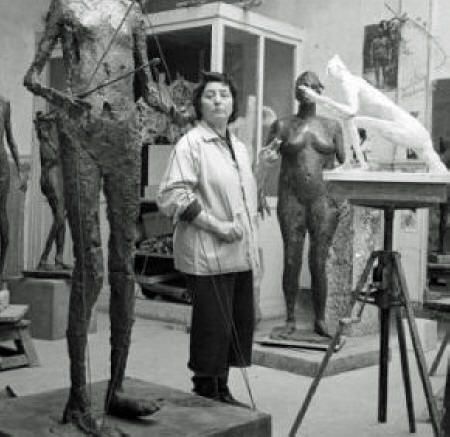

Queer Places:
Bergstrasse 157, 8032 Zürich, Switzerland
36 Avenue Jean Moulin, 75014 Paris, France
Cimetière de Mudaison
Mudaison, Departement de l'Hérault, Languedoc-Roussillon, France
 Germaine Richier (16 September 1902 – 21 July 1959) was a French sculptor.[2]
Artist Liv Schulman
created a series of films: Le Goubernement, a six-episode fiction imagining
the destiny and work of women, lesbian, queer, trans and non-binary artists
who lived in Paris from 1910 – 1980. The episodes traverses and overlay over
70 years of history and hosts the stories and fate of artists that were erased
from the great twentieth century modernist narrative including Germaine
Richier.
Germaine Richier (16 September 1902 – 21 July 1959) was a French sculptor.[2]
Artist Liv Schulman
created a series of films: Le Goubernement, a six-episode fiction imagining
the destiny and work of women, lesbian, queer, trans and non-binary artists
who lived in Paris from 1910 – 1980. The episodes traverses and overlay over
70 years of history and hosts the stories and fate of artists that were erased
from the great twentieth century modernist narrative including Germaine
Richier.
Born in Grans, Richier began her studies at the Ecole des Beaux Arts in Montpellier, in the atelier of Louis-Jacques Guigues; in 1926 she went to work with Antoine Bourdelle, remaining in his studio until his death in 1929. There she became acquainted with Alberto Giacometti, although the two were never close. Richier for her part was more interested in a classical approach to sculpture, preferring to work from a live model and then reworking the final product. She also met César Baldaccini at this stage in her career. She married Otto Bänninger on 12 December 1929. In 1936, she won the Prix Blumenthal. During the war, she met Marino Marini, in exile in Switzerland.
Richier's early work was fantastic, combining classical forms with human-animal hybrids and depicting creatures such as the spider and the hydra. Her style became less figurative after World War II; the bodily deformations which she favored as subjects were more accentuated in an attempt to convey a greater sense of anguish.
At the declaration of war in September 1939, Germaine Richier and Otto Bunninger were in Switzerland. They settled in Zurich, No. 157 Bergstrasse. "Until the war, Germaine Richier remained a well-mannered sculptor, in the tradition of volume and statuary. . . . It is in Switzerland, where she resided during the Occupation, that she undermined the unity of her statuary, and defeated the classical balance that she was so good at managing.. »
In October 1946, Germaine Richier returned to Paris because: "Her existence and sculpture can only be in his country, in Paris. » Together with Otto Bunninger, she lived between France and Zurich and corresponds very regularly with him : "Basically, it was Bunni who introduced me to art and it is to him that I owe the emancipation of my bourgeois life. » But in Paris she found her old friends, to which were added literary elements including Marcel Arland, Nathalie Sarraute, Colette, Edmond Humeau, Jean Paulhan. She found a studio on the Avenue de Châtillon and her creative freedom explodes with hybrid figures.
In November 1946, she met the writer and poet René de Solier, who would become her companion. He communicates his enthusiasm to his friend Jean Paulhan, as well as to the poet Francis Ponge and the writer André Pieyre de Mandiargues: "To my taste, it is almost only a few women who save the painting today, and it is Richier who saves the sculpture. » Solier became his companion a few years later. In 1954, Germaine Richier divorced and remarried René de Solier.
The greatest controversy surrounding Richier's work came about with her creation of a statue of Christ for the church of Notre-Dame de Toute Grâce du Plateau d'Assy.[3] Meant to depict the physical and spiritual torment of Christ, she explained that: the cross has been taken with the suffering into the flesh, and its outlines can just be made out coming from the undersides of the arms. There is no face because God is the spirit and faceless....[4] The sculpture was ordered removed from sight by the bishop of Annecy.[5] This event was the catalyst for a great argument about the nature and role of sacred art which took place throughout the 1950s, during which many artists found themselves opposed to the traditional role of religious and academic art. Some have also described the controversy as a debate over the nature of God in modern society. Richier, for her part, gained some notoriety from the entire business, but seemed to retreat into obscurity again before her death in 1959.
Retrospectives of her work were held at the Peggy Guggenheim Collection,[6] and the Fondation Maeght in Saint-Paul, Alpes-Maritimes.[7] Her works are in the Tuileries Garden, Musée Fabre, and the Tate Collection.[8] Richier was celebrated on a postage stamp issued by La Poste in 1993 as part of a commemorative series depicting artists.
My published books: